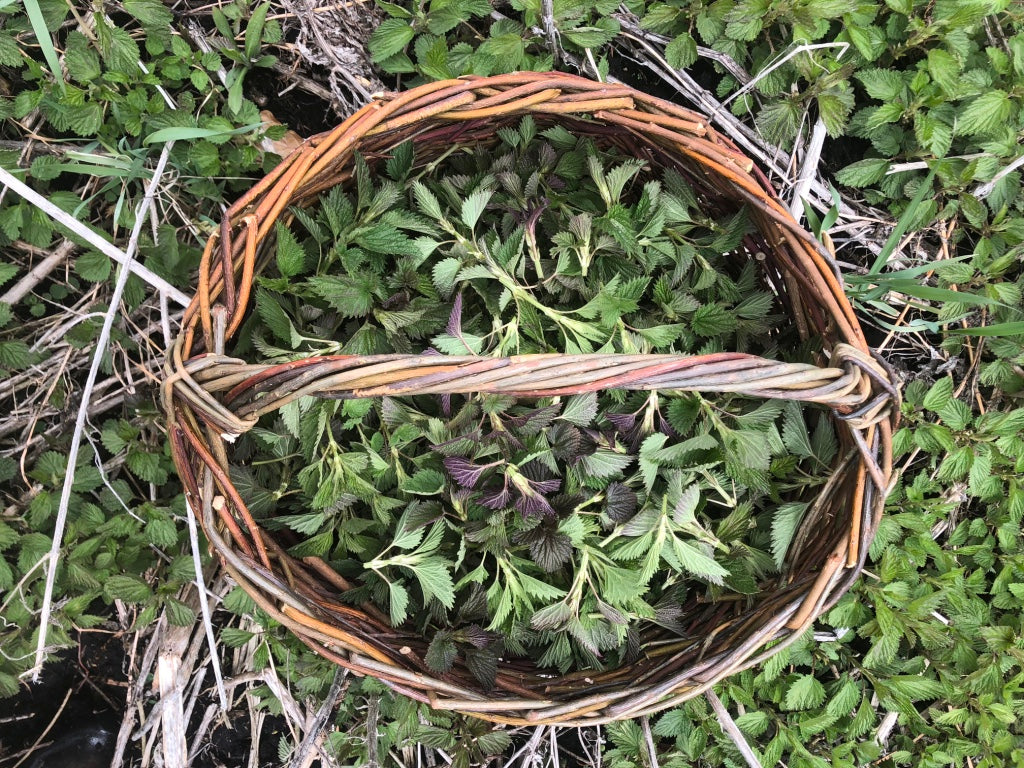More nutritious than your favorite vegetable, promise
NETTLES
Urtica dioica, Urticaceae
My plant profile on Nettles, pulled from the course booklet for Bioregional Herbalism & Medicine Making:
Harvest: The young shoots and leaves in mid-late spring. Stop harvesting the leaf once the plant flowers. Harvest the seed in late summer. The root can be harvested in autumn.
Stinging Nettles thrive in nutrient rich wayside places: old manure piles, septic fields, the edges of agricultural fields. These rich soils in which Nettles grow generally have a steady water source, especially in spring. Those who do not appreciate the virtues of Nettles consider them a scourge because they can easily cover acres of land if the conditions are right. The aggressive growth habit of Nettles, paired with the million of stinging hairs the plants are covered in make it a hard plant to remove, as many farmers wish to do. On the other end of the spectrum, when I found a small Nettle patch peeking out of a hillside on our land in the finger lakes, I immediately got to work weeding the patch and top dressing it with compost to encourage it to take over the whole hillside. Members of the Urtica genus are native all around the world.
 An early spring harvest of Nettle tops
An early spring harvest of Nettle tops
The young shoots, leaves, seeds, and roots all have recorded uses. I primarily work with the young shoots, leaves, and occasionally seeds. The root, according to Matthew Wood in The Practice of Traditional Western Herbalism is used in prostate related issues, however I will not be expanding on any root uses as I have no experience with them. The seed is specific for acute kidney related issues. Unless otherwise indicated, I am referring to the young shoots and leaves in this plant profile.
Nettles key uses in the apothecary are building up nourishment through their incredibly high content of vitamins and minerals, relieving symptoms of allergies, helping reduce the pain of rheumatism and gout, and relieving the pains of arthritis through urtication.
Nettles are the ideal nutritive tonic. They are rich in Potassium, Magnesium, Calcium, Iron, Protein, Vitamin K, A and C. Daily watery infusions of Nettles are recommended as a remedy for people with anemia, low blood pressure, or general fatigue. Nettles is one of the few herbs I recommend during pregnancy, in this case it can be combined with red raspberry leaf and alfalfa for a daily tonic tea. Although Nettles contain no caffeine, the effect of the rich nourishment can be stimulating. Nettles are among the first plants to come up in spring and I love to work with them as a nourishing spring tonic to help me prepare for the increased physicality of summer. I infuse Nettles in vinegars (an excellent solvent for minerals), cook the fresh shoots in the skillet, and dry as much as possible for tea. Nettles should not be consumed raw as the hairs can sting your mouth. Cooking, infusing in hot water, and drying all wilt the stinging hairs which could otherwise irritate the throat passageway and cause harm.
 My favorite spring soup: Nettles & Morel mushrooms
My favorite spring soup: Nettles & Morel mushrooms
Nettles are usually the first herb I think of when someone is suffering from seasonal allergies. They mildly desensitize the mucosa that are over reacting to allergens and assist in removing excessive phlegm. This action combined with their general anti-inflammatory properties makes them a great choice for combating the symptoms of seasonal allergies at their on-set. Nettles increase the excretion of uric acid, therefore making them helpful in the case of rheumatism and gout. For allergies, rheumatism, and gout, Nettles should be drank as a watery infusion.
In my last point about Nettles, I finally discuss the first thing most people notice about them: their stinging hairs! The stinging hairs primarily exist on the underside of the leaf and the stem, but you will find some on the top of the leaves as well. Each one of these little hairs is poised and ready to inject histamine and acetyl-choline into the skin. The result is a stinging sensation and raised bumps for most people. However, if a person is suffering from arthritis, rubbing against Stinging Nettles overloads the pain signals in the area rubbed by the Nettle hairs and blocks the pain signals of arthritic joints. I used to work with a gardener in his 40s who had arthritis in one elbow. On days when it would flare up, he would visit our Nettle patch, chop a branch and rub it all over his painful area. At first he would be wide eyed with the painful stimulation of the Nettles, but quickly that would subside and his relief from arthritis pain would last throughout the day.
WARNING: Do not eat Nettles raw. Cooking, infusing in hot water, and drying wilts the hairs and makes Nettles safe to consume internally.
Medicine Making: I do not recommend tincturing Nettles. Their medicinal properties are best extracted through water and vinegar. Note that Nettle is a drying herb and daily consumption can be overly drying for some constitutions.
Watery Nettle infusion: 1/4 cup of dried Nettle leaf in a quart sized mason jar or tea pot with just boiled water poured over up to the fill line. Covered. Steeped at least 20 minutes, but ideally overnight for maximum extraction. I tend to combine my Nettle infusions with moistening herbs like marshmallow & violet as alone it can be slightly drying. Drink as a nourishing tonic.

